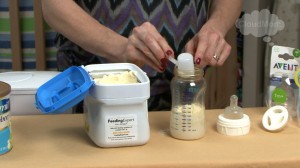Tips: Formula Feeding Basics
 Choosing and preparing baby formula can be confusing, especially when you’re a sleep-deprived new mom! There are so many choices and it’s easy to get overwhelmed, so I’m going to walk you through all the basics, from types of formula to bottles and much more.
Choosing and preparing baby formula can be confusing, especially when you’re a sleep-deprived new mom! There are so many choices and it’s easy to get overwhelmed, so I’m going to walk you through all the basics, from types of formula to bottles and much more.
The American Academy of Pediatrics (AAP) does recommend breastfeeding your infant exclusively for six months, but whether you breastfeed and supplement, formula feed from the start, or are in the midst of transitioning to bottles and formula feeding from breastfeeding, you are in the same boat as most parents who do give their babies formula at some point during the first year.
Types of Formula
- Cow’s Milk Formula: There are many different options within this category, including organic, so it’s all about finding what works best for your baby. It makes sense to buy small quantities to start out with.
- Soy Formula: This formula uses soy-based proteins and is an option for babies who can’t tolerate cow’s milk.
- Lactose Free Formula: All soy formulas are lactose free, and there are also cow’s milk-based formulas that are specially formulated to be lactose free.
Formula Options
- Powdered
- Concentrated Liquid
- Ready to Feed Liquid
Most moms I know use powdered infant formula for convenience and cost. You can control the measurements as necessary; it’s the cheapest option and it takes up less space storage-wise. Check with your doctor about whether you can use tap water for mixing — it depends on the purity and fluoride levels where you live.
The ready to feed liquid is more expensive but is a great choice for travel or if you’re someplace without access to good water.
Important Formula Feeding Tips
- Use Iron Fortified Infant Formula
Always make sure you use an iron-fortified formula per the recommendation of the AAP during your baby’s first year of life. Iron is very important to baby’s growth and development.
- Check Expiration Date
Always check the expiration date on the formula can. Formula can go bad and be unsafe for your baby, and stores don’t always clear the shelves of expired containers.
- Use Can Within One Month
Once a container is opened, it’s good for one month.
- Don’t Leave Mixed Powdered Formula at Room Temp for More Than One Hour
Formula has a very short shelf life at room temperature after the powder is mixed with water. Do not leave powdered mixed formula at room temperature for more than an hour and always throw out what your child does not drink.
- Safe to Store in the Refrigerator for 48 Hours
Once you mix the powder with water it will keep for up to 48 hours in the refrigerator.
Preparing Formula
- Begin with clean hands and a clean bottle and nipple.
- Add water to the bottle first to the measurement you desire, and then add the formula. If you add the formula first it can skew the measurement of the water.
- Typically one level scoop of the powder makes for two ounces of formula liquid. But make sure to read the instructions on the can just to be safe.
- Use room-temperature water, which will make it easier for the formula to dissolve. You cannot change quantities and add less formula per water, this is dangerous because your baby won’t be getting enough nutrients!
- Once you’ve added the formula to the water already in the bottle, put the top on and shake the bottle so that the powder and water mix thoroughly. Make sure the formula is completely dissolved and incorporated into the water before administering to your baby.
Warming Formula
- Don’t warm bottles in the microwave, because this can cause “hot spots” or unevenness in temperature.
- You can warm the formula by leaving it out of the fridge for 1 hour, or placing it in a pan of hot water.
- Test the temperature on your wrist to make sure it’s not too hot before feeding it to your baby.

